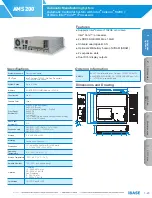
B-32
INST
ALLA
TION PROCEDURE
600
o
600
CEILING
CASSETTE
CEILING CASSETTE
S series
1 2
L N
30
46
30
30
120
83.5
AB
TB6
•
Perform wiring as shown in the diagram to the lower left. (Procure the cable locally).
(Fig. 7-4)
Make sure to use cables of the correct polarity only.
Connecting cable
Cable 3-core 1.5 mm
2
, in conformity with Design 60245 IEC 57.
Indoor terminal block
Outdoor terminal block
Always install an earth wire (1-core 1.5 mm
2
) longer than other cables
Remote controller cable (non-polar)
Cable 2-core 0.3 mm
2
The 10 m wire is attached in the remote controller accessory. Max. 500 m
Wired remote controller
Power supply cord
Caution:
•
Use care not to make miswiring.
•
Firmly tighten the terminal screws to prevent them from loosening.
•
After tightening, pull the wires lightly to confirm that they do not move.
7. Electrical work
Fig. 7-4
Fig. 7-5
7.3. Remote controller
7.3.1.Wireless remote controller (Fig. 7-5)
1) Installation area
•
Area in which the remote controller is not exposed to direct sunshine.
•
Area in which there is no heating source nearby.
•
Area in which the remote controller is not exposed to cold (or warm) winds.
•
Area in which the remote controller can be operated easily.
•
Area in which the remote controller is beyond the reach of children.
2) Installation method
Attach the remote controller holder to the desired location using two tapping screws.
Insert the lower end of the controller into the holder.
•
The signal can travel up to approximately 7 meters (in a straight line) within 45
degrees to both right and left of the center line of the receiver.
In addition, the signal may not be received if there is interference of light of fluores-
cent lights or strong sunlight.
7.3.2. Wired remote controller
1) Installing procedures
(1) Select an installing position for the remote controller. (Fig. 7-6)
The temperature sensors are located on both remote controller and indoor unit.
Procure the following parts locally:
Two piece switch box
Thin copper conduit tube
Lock nuts and bushings
Remote controller profile
Required clearances surrounding the remote controller
Installation pitch
(2) Seal the service entrance for the remote controller cord with putty to prevent pos
sible invasion of dew drops, water, cockroaches or worms. (Fig. 7-7)
For installation in the switch box:
For direct installation on the wall select one of the following:
•
Prepare a hole through the wall to pass the remote controller cord (in order to run
the remote controller cord from the back), then seal the hole with putty.
•
Run the remote controller cord through the cutout in the upper case, then seal the
cutout notch with putty similarly as above.
B-1. To lead the remote controller cord from the back of the controller:
B-2. To run the remote controller cord through the upper portion:
(3) For direct installation on the wall
Wall
Conduit
Lock nut
Bushing
Switch box
Remote controller cord
Seal with putty
Wood screw
2) Connecting procedures (Fig. 7-8)
Connect the remote controller cord to the terminal block.
To the terminal block on the indoor unit
TB6 (No polarity)
3) Function selection of remote controller
If two remote controllers are connected, set one to "Main" and the other to "Sub". For
setting procedures, refer to "Function selection of remote controller" in the operation
manual for the indoor unit.
Wireless remote controller (Accessory)
Wall
Remote controller holder (Accessory)
Fixing screw (Accessory)
B-2.
Fig. 7-7
Fig. 7-6
Fig. 7-8
B-1.
Indoor/outdoor unit
connecting wire
3-core 1.5 mm
2
or more
Outdoor terminal block
Power supply cord
Indoor terminal block
Earth wire (green/yellow)
















































